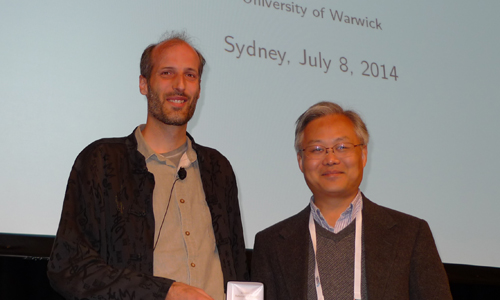The Fields Medals are the most prestigious awards in the field of mathematics, awarded every four years by the International Mathematical Union. Among this year’s four recipients is IMS member Martin Hairer (University of Warwick, UK), who delivered a Medallion lecture at the IMS annual meeting in Sydney in July.
Ofer Zeitouni explains some of the background to Martin’s work:
Martin Hairer of the University of Warwick is one of the four recipients of the 2014 Fields medal, awarded on August 13 during the International Congress of Mathematicians in Seoul. The citation reads: Martin Hairer is awarded a Fields Medal for his outstanding contributions to the theory of stochastic partial differential equations, and in particular for the creation of a theory of regularity structures for such equations.
For probabilists and statisticians, the solution of stochastic ordinary differential equations involves Itô’s theory; while extremely powerful and useful, Itô’s method is crucially based on the martingale property of Brownian motion and does not generalize well to situations where the noise depends both on time and space. The latter is what happens in the case of stochastic partial differential equations; one often gets from physical considerations equations with terms that are not well defined, because they involve non-linear functions of distributions. Particularly well known examples are the Kardar-Parisi-Zhang (KPZ) equation and the so called $\Phi_4^3$ equation of quantum field theory.
Hairer’s theory of regularity structures allows one to give a sense to these equations. First, one mollifies the noise as to obtain a classical SPDE. The limit as the mollification is turned off, however, cannot be directly taken because of divergences. Hairer invented a method that expands the solutions in a basis (determined by the equation) and then renormalizes (a finite number of terms in the expansion) in order to give sense to the limit as the mollification is tuned off. As a result, one obtains the solution of the original SPDE as the limit of classical solutions of (modified) equation driven by mollified noise. The extra correction term is reminiscent of the Wong-Zakai correction term in the theory of SDEs, but the computation of the correction term requires the full power of Hairer’s theory and is much more subtle.
In addition to this major achievement, Hairer made other spectacular contributions to the theory of SPDEs. In particular, together with Jonathan Mattingly of Duke University he introduced the notion of asymptotic strong Feller property and used it in a proof of ergodicity for two dimensional stochastic Navier-Stokes equations.
Congratulations, Martin, on this wonderful achievement.
You can read a longer profile of Martin Hairer in the Simons Foundation Quanta Magazine.


Comments on “Martin Hairer wins Fields Medal”